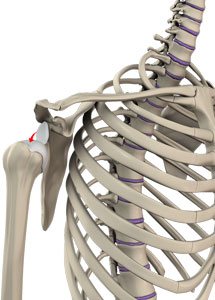
Anatomy of the Shoulder
The shoulder joint is a ball and socket joint. A ball at the top of the upper arm bone (humerus) fits neatly into a socket, called the glenoid, which is part of the shoulder blade (scapula). The glenoid is surrounded by a ring of fibrous cartilage called the labrum for stabilization of the shoulder joint.
What is Shoulder Dislocation?
Sports that involve overhead movements and repeated use of the shoulder at your workplace may lead to sliding of the upper arm bone from the glenoid. The dislocation might be a partial dislocation (subluxation) or a complete dislocation causing pain and shoulder joint instability. The shoulder joint often dislocates in the forward direction (anterior instability), and sometimes in the backward or downward direction.
Symptoms of Shoulder Dislocation
The most common symptoms of shoulder dislocation include pain and shoulder joint instability. Other symptoms such as swelling, numbness and bruising may also occur. At times, it may cause tears in the ligaments or tendons of the shoulder and nerve damage.
Diagnosis of Shoulder Dislocation
Your doctor will examine your shoulder and may order an X-ray to confirm the diagnosis.
Treatments for Shoulder Dislocation
The condition is treated by a process called closed reduction, which involves placing the ball of the upper arm back into the socket. Following this, the shoulder will be immobilized using a sling for several weeks. Ice may be applied over the area 3-4 times a day. Rehabilitation exercises may be started to restore range of motion, once the pain and swelling decrease.
Related Topics
- Frozen Shoulder
- Shoulder Instability
- Arthritis of the Shoulder
- Acromioclavicular (AC) Arthritis
- Rotator Cuff Tear
- Shoulder Pain
- Anterior Shoulder Instability
- Posterior Shoulder Instability
- SLAP Tears
- Shoulder Labral Tear
- Shoulder Fracture
- Clavicle Fracture
- Glenoid Fractures
- Proximal Humerus Fractures
- Shoulder Trauma
- Rotator Cuff Pain
- Shoulder Disorders
- Subacromial Impingement Syndrome
- Overhead Athlete's Shoulder
- Shoulder Impingement
- Shoulder Dislocation
- Little League Shoulder
- Proximal Biceps Tendon Rupture
- Shoulder Labral Tear with Instability
- Baseball and Shoulder Injuries
- Acromioclavicular (AC) Joint Osteoarthritis
- Proximal Biceps Tendinitis
- AC Joint Separation
- Shoulder Tendonitis
- Throwing Injuries of the Shoulder
- Internal Impingement of the Shoulder
- Rotator Cuff Re-tear
- Rotator Cuff Calcification
- Partial Rotator Cuff Tear
- Bicep Tendon Rupture
- Calcification Tendinitis
- Periprosthetic Shoulder Fracture
- Long Head Biceps Tendon Rupture
- Multidirectional Instability of the Shoulder








